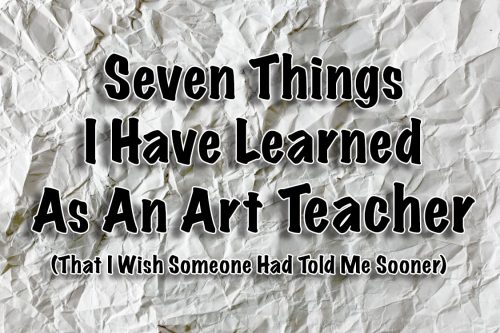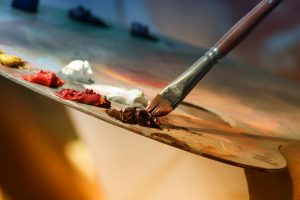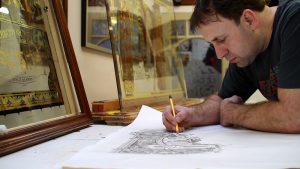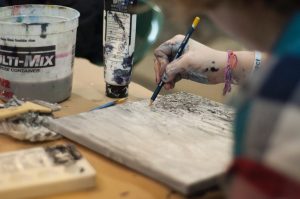
As I begin my 9th year as a High School Art Teacher, I took some time to look back at all of the experiences I have had along the way. I am starting this year at my 4th different school district and my 4th different classroom. I have started unpacking the boxes and the distracted reminiscing that comes with finding old documents and old projects. Although that part is fun, it doesn’t really help me get a good start at my new school.
 I will never pretend to be a great teacher. In fact, I am not sure that I am even a good teacher. But I love what I do and why I do it. I love helping people understand information. I have worked with the Boy Scouts of America since I was a Cub Scout and took opportunities to instruct and lead as much as I could along the way. When it came to a career, I kept coming back to teaching as an option. Now that I am nearly a decade in to it, I realize, this is what I want to do. Some way, somehow, I NEED to be a teacher (even if it is not in a school setting).
I will never pretend to be a great teacher. In fact, I am not sure that I am even a good teacher. But I love what I do and why I do it. I love helping people understand information. I have worked with the Boy Scouts of America since I was a Cub Scout and took opportunities to instruct and lead as much as I could along the way. When it came to a career, I kept coming back to teaching as an option. Now that I am nearly a decade in to it, I realize, this is what I want to do. Some way, somehow, I NEED to be a teacher (even if it is not in a school setting).
That being said, I have come up with some tips/realizations I have learned along the way. These hopefully will help other art teachers as well as other artists, creative minds, or any one else who cares to listen.
1. Embrace the Chaos

In teaching, as in life, you try to make plans and stick to them. It’s human nature to want to plan things out to the second and follow through so things run smoothly.
“Life is what happens while you are busy making other plans” ~John Lennon
Embrace the chaos. Now, I don’t mean to let your classroom (life) get out of control to the point where you are no longer the authority in the room, but embrace the chaos as a way to engage your students and give them choices on how they want to learn. You get to choose what they are studying, but all students (people in general) learn differently, so why try to force them all to learn the one way you are willing to teach.
2. Ask For Help

You are going to have to be your own advocate. No one will fight for your department, your classes, for you as well as you can. But when you don’t know the answer, find people that will help you. If you are fortunate enough to be in a situation with multiple art teachers in your building, use them as a resource when you get stumped. Chances are, they are veteran teachers who have file cabinets full of lesson plans, projects, or just ideas that they would be willing to share with you. Also, sites like TeachersPayTeachers and Pinterest have millions of ideas for lessons. If you are in a situation where you are the only Art Teacher in the building, find other elective teachers, or a neighboring teacher, just find someone that you can talk to and ask questions. Do not maroon yourself on an island in your classroom, you will burn out too quickly.
3. Don’t Steal Their Struggle

Failure is key to learning. Failure is key to success. Failure is a good motivator to learn. Do not keep students from “failing” at a technique, concept, project, etc. Instead, allow your students to explore and engage with the information you have given them. People in general do not like to fail at anything, so you have to condition your students to understand that the end product isn’t always what is most important. I see more learning in a student who took a big risk and failed than a student who took the easy way out and was successful. Especially in Art, big risks are what get you noticed. I have seen at different Art competitions, the pieces that win awards aren’t the ones that are the most realistic, brightest colors, etc., they are typically the ones that took big risks and did something that other people aren’t doing. Of course, sometimes big risks don’t pay off with an end product, but you will learn so much more from seeing WHY it didn’t work. (This goes for lesson plans as well, not just student projects)
4. Don’t Let It Control You

Make sure to take time for your self. Being a teacher can become all consuming if you let it. There are always papers that you could take home to grade, projects to be planned, materials to be prepped. I can remember as a first year teacher and a coach, I was at the school around 5:30am and left some nights after 11pm. Thankfully I didn’t have pets or a family to worry about, but it became very taxing on me that first year until I learned strategies on how to manage my time better. Now, I am more efficient with my time and have found better ways to group things together to be more efficient. Of course, some of that just comes with experience as a teacher.
5. Be Flexible

In a school, there is no “Normal Day”. Sure, there are some days that will have the same schedule, or the same classes, but every day is different. Be ready to change plans at the last minute, not have enough materials, etc. One of my schools was 1:1 with every student having iPads. I had a great lesson planned for the iPads with introductions, mini lessons, examples, the works. Then, on the day we were going to do the lesson, the WIFI wasn’t working. Plans change, so be ready. (We were able to do the project a few days later, so that work was not wasted)
6. Don’t Be Afraid To Say No

You will be, in most situations, the most “creative” person in your building. Or at least that is how the rest of the building will see you. You are under no obligation to help out every poor soul that comes asking for you. By all means, be as helpful as you would like. But beware, the more you say “Yes”, the harder it becomes to say “No”. Also, your classroom supplies are for your classroom, regardless if the other teachers treat your room as a supply closet. If you don’t want to supply poster paper for the entire school, then be firm when the masses come around.
7. Don’t Let It Keep You From Creating Your Own Artwork

You started down the road to be an art teacher for a reason. Don’t let the stress of all of this keep you from creating your own artwork. Use it as a release from the day-to-day stuff, or just sit down with your students and create along side of them. My students love seeing what I am working on, even when it isn’t the same type of project they are working on. If anything, it will show the students that you know what you are talking about when describing new techniques or projects.

Above all, understand that Art may be your passion, but being a teacher is your job and you are human. You are allowed to make mistakes, you are allowed to have good days and bad days. Hopefully you have more good days than bad days, but still. This is by no means a definitive list of “Things You Should Know As An Art Teacher” or anything like that, mostly just some rambling from me as I sit in my messy classroom trying to figure out how it should be organized.
~Cpt.

